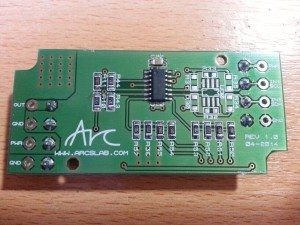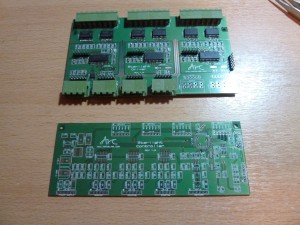Archive for the ‘Projects’ Category
May 20th, 2014
I finally found some spare time to upload the schematic for the Arc Dimmer:


Everything should be straightforward so I’m just going to give you a few notes on the optional components. If you want to build a stand-alone dimmer which is controlled via buttons and/or potentiometers, place components R36-R39, C30-C31 and D30-D31. If you want to build an I2C bus-controlled dimmer, place components U30 and R30-R35 (with the exception of R32/R33). U40 and U41 are there just to provide different footprints on the PCB.
PDF version of the schematic can be found on the Projects page.
May 19th, 2014
My friend asked me if I could make him a push-button controlled LED dimmer, so I did! And went a bit haywire with the options list, as usual. Instead of making a single-purpose dimmer I decided to make it a bit more universal and bulletproof. Here are the basic specs:
- operating voltage: 12-24V DC
- load current: up to 10A (or more with a different output switch)
- protected against overvoltage, overcurrent and overtemperature
- two configurable control inputs
- optional I2C interface for bus control
- status and power LEDs
The PCBs arrived a few days ago and I assembled one unit for testing. A few parts are missing because they are on order and should arrive soon. Here are a few pics until I prepare the documentation:



January 25th, 2014
Delivery of new PCBs was delayed because of the holidays but now I finally have a complete set so I can get to work on actual firmware.


Most of the parts are populated; all hand soldered because I was lazy to take out my hot air station. First attempt at TQFP soldering and all went well. Of course, nothing is complete without a bodge. I first soldered the 3.3V PIC instead of the 5V one so the power pad got lifted during desoldering. D’oh!


January 2nd, 2014
Santa made me very happy the other day when I saw an envelope in my mailbox. Since I ordered two different PCBs I wasn’t sure which one was in the envelope but it turned out it was the Driver PCB for my Starlight Controller project. Excuse the crappyness of my phone’s pictures but my digital camera is on holidays until further notice…


And a short rant time! While designing the PCB I used the terminal connectors’ datasheet as a guide for hole placement. Apprently, I was looking at the wrong datasheet because my connectors hang off the PCB by 1mm. Instead of 10mm hole-to-edge distance my connectors have 11mm distance. Normally this wouldn’t be a problem but since this PCB is supposed to go into a DIN-rail enclosure I could face some problems later…

January 2nd, 2014
A few years ago I made a simple stair lights controller for my parent’s house. Powered by a single PIC16F877 running at 20MHz it had 20 pwm channels and an RS485 interface that I never fully implemented (it simply wasn’t needed). Outputs were driven by BSP170 mosfets that turned out to be highly sensitive to ESD during soldering but pretty reliable when soldered to a PCB. As I was still learning how to program microcontrollers at that time I was fascinated by the things you could accomplish with a microcontroller so instead of having a simple one-by-one animation I decided that a wave-like effect would be better. Everything was placed on a single PCB with through-hole components and I was extremely proud of my work. This simple circuit ran flawlessly for the past 4 years until it met its archenemy – the water! As you already know, water doesn’t mix well with electronics and although nothing blew up (except the fuse in the power supply) there was severe oxidation all over the PCB and…well…now it’s time to make a new version. Bigger and better than before!
And so the Starlight project was born. Basic idea is something like this: provide a decent amount of PWM outputs for LED strips and avoid previous design flaws. And overcomplicate things, bwahahahaha!! Here are my initial specifications:
- 24 PWM channels (because 24 is multiple of 8)
- up to 1A of output current per channel
- up to 4 digital inputs (for proximity sensors)
- up to 2 analog inputs (for…something…a light sensor?)
- CAN interface for future expansion
- USB interface for configuration
- a few status LEDs (because everybody loves blinking lights!)
- optional configuration PCB for stand-alone configuration
I have already received one PCB for the PWM drivers and the controller PCB is on the way. Unfortunately, due to the holidays I didn’t have enough time to actually order parts so now I have to wait until everything arrives (a week or so). It’s very sad to look at the finished PCBs and not have the parts to solder…
January 12th, 2010
This project is intended as a countdown timer for a UV exposure box for PCB development that uses fluorescent UV lamps (it will also work with any other lamp, don’t worry). It is based around a PIC16F627 micro and has following features:
- adjustable time in 15-second increments (up to 10 minutes)
- lamp preheat feature
- two button operation (with audible feedback)
- countdown alarm (when timer reaches zero)
- relay for lamp switching
- 7-segment display
10 minutes?
I have chosen the upper time limit of 10 minutes which should be more than enough for most applications and initial time is set for a 5 minute countdown (I’m preparing a revised software which will load initial time from EEPROM so it can be configured manually). Step increment of 15 seconds has been chosen partially due to ease of operation because there are only two buttons – time adjustment and start/stop. Time adjustment is incremental meaning that each time you press the button time is incremented by 15 seconds. When upper limit is reached time is reset to zero and the process repeats. Start/stop button is used for, you will never guess, starting and stopping the timer with lamp preheat feature.
Read the rest of this entry »












